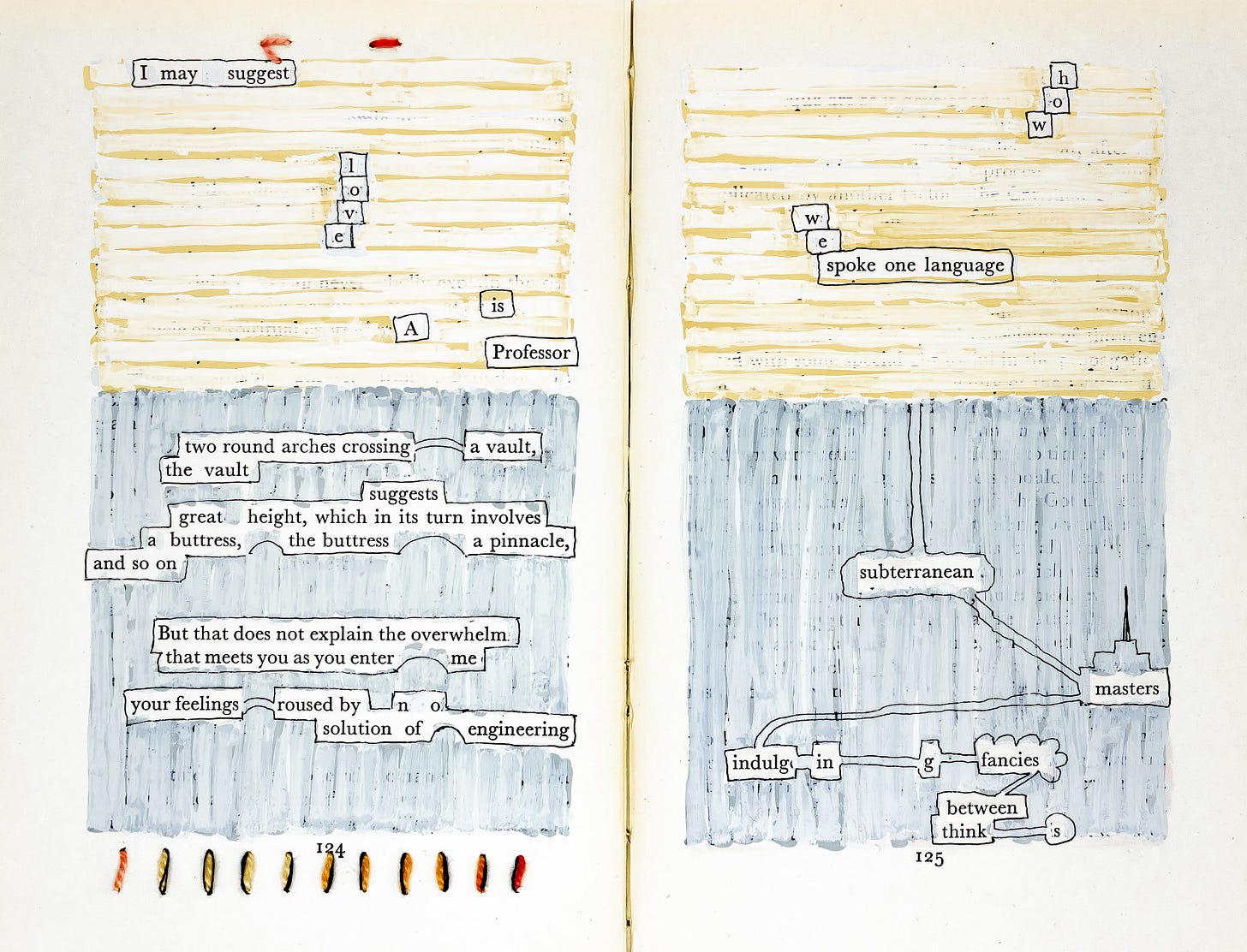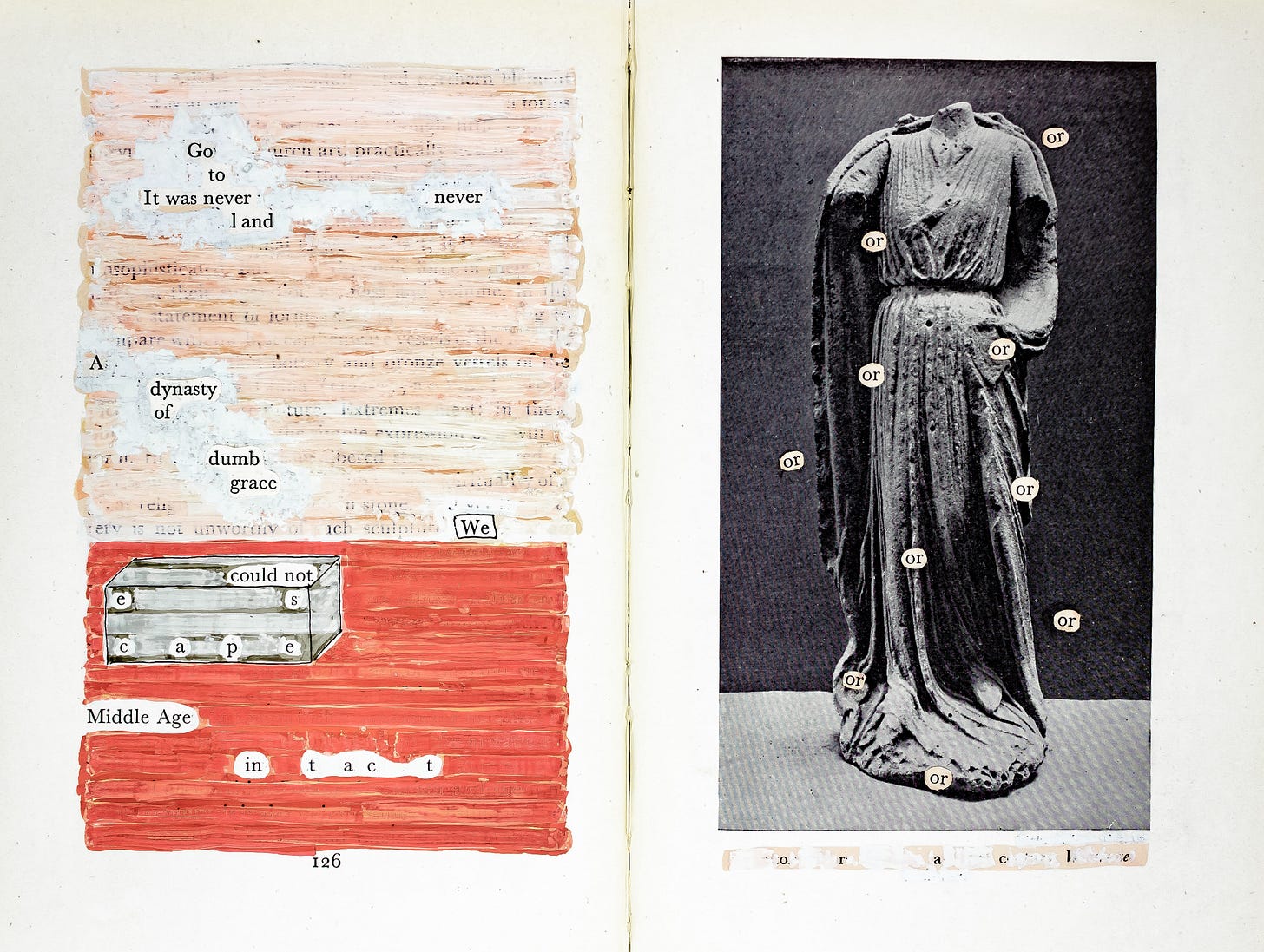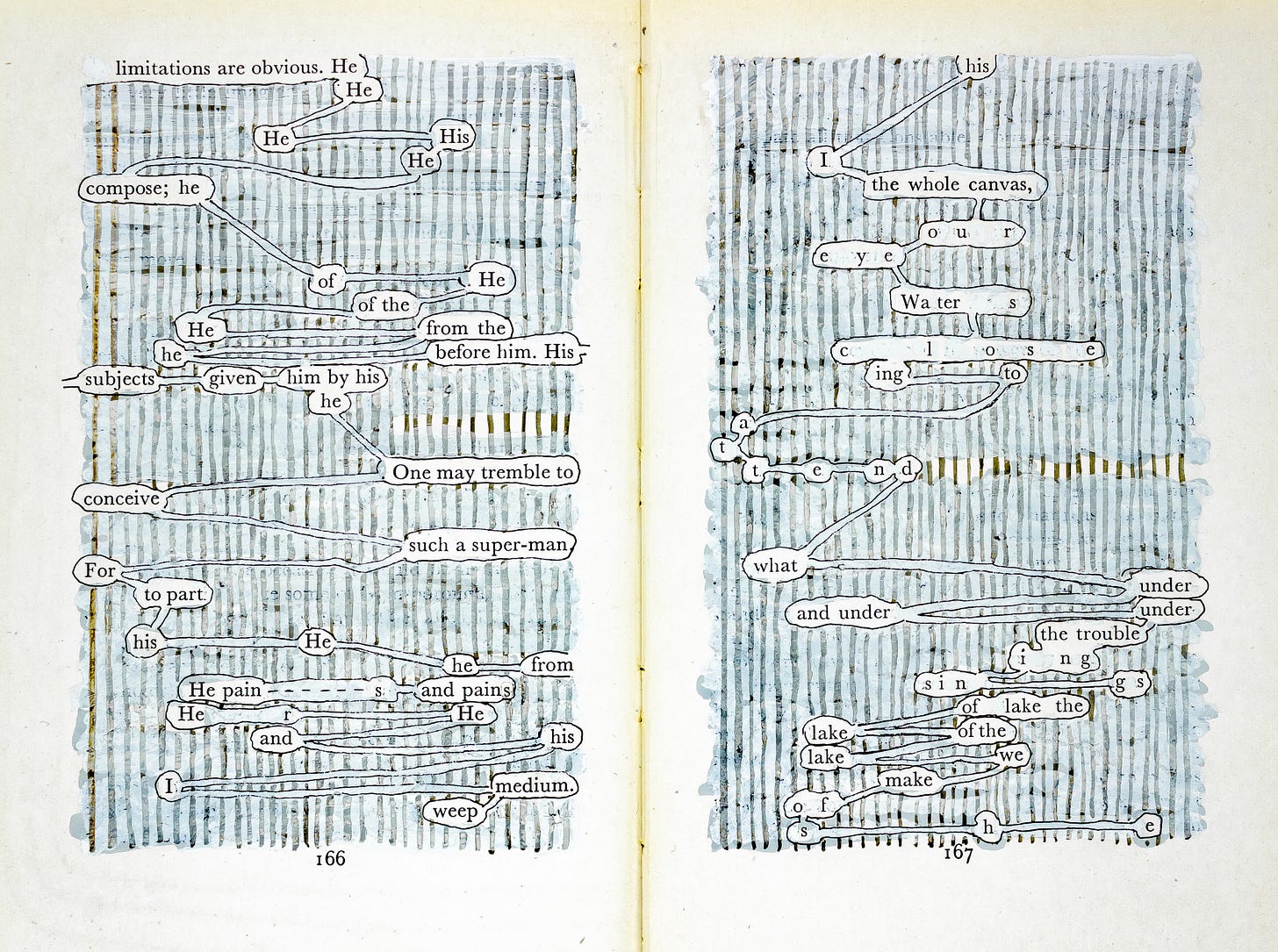Birthdays & Hazard Pay
Celebrating writing through not-knowing & danger-facing books old & new.
Last Monday, I launched this Octopodal stack. I’m still finding my sea legs.
That day was also the 4th birthday of Her Read, A Graphic Poem (TRP, 2021), a weirdo feminist manifesto I began the summer of 2016—amid that U.S. presidential election.
It feels melodramatic to say it, but it saved my life.
I think of it as a long, book-length poem. Here’s a smattering:
What you’re looking at is poetic erasure1— the radical upcycling of a pre-existing work. In these, I used correction fluid, ink, glue, scalpel & thread to alter a 1951 edition of The Meaning of Art by Herbert Read (Faber & Faber, 1931), a survey of art from prehistory to modernity. The Meaning of Art includes zero female artists.2
In fact, in 266 pages of text, Sir Herb3 deploys the “she” pronoun only once & not until the 3rd edition (1951) when he tacks on a chapter featuring his friend, Barbara Hepworth.
Here are two spreads that speak to she’s absence:
I usually don’t celebrate my book birthdays out loud, but I like it when others do. I want to celebrate friends’ work rippling through the world. And temporal markers help me keep perspective. Other people’s kids seem to grow faster than our own, but no one reaches adulthood w/o going through adolescence.4
I picked up The Meaning of Art because I dug the cover, kept it for the canon— “mastery” reduced to grainy, 4”x6” black & whites. But though hunting for a book to dismantle, hoping subversive experiment might end my rage-induced silence, I didn’t realize I’d grabbed an artifact of gendered erasure—a history of the art of silent women— till I was 50 pages into the remodel. By then, a wry femme, having crawled through millennia of stone & rubble, was already clearing her throat. It felt like magic. Like witchcraft. Like channeling.
Reader, in keeping w/the theme of charging ahead, despite only the foggiest sense of what you’re doing, let me confess, I don’t yet know what Hazard Pay has to do with this post. I liked that it rhymed w/birthday. And my gut says I’m on the money…
My gut is messed up. When I made Her Read, I was suffering from undiagnosed chronic illness. I glance on this in the Apologia,5 Her Read’s lyric preface, which I later made into a short video. It’s filled w/images from art museums I visited in Her Read’s gestational period. There’s also a 1991 clip of me dancing.
It felt important to offer a personal account of the book’s origins because, although Her Read is informed by my experience of chronic illness (& misogyny, gaslighting, etc.) I wasn’t writing about those experiences directly. I tried instead to tell a larger, cultural story via poetic persona.6
My forthcoming book, Boys Behind Glass, has similarities to Her Read, but its formal strategies are radically different.
Like Her Read, BBG is in conversation w/other texts,7 beginning w/the art of Jenny Walton, a painter I met at Vermont Studio Center in January of 2017, pussy hats marching. Jenny had recently completed Match/Enemy, a catalog of 200+ portraits: watercolor replicas of the profile pics of men she matched on OK Cupid, specifically men whose pictures elided identity. A study of masculinity as performed via anonymity. I wanted to try my hand at poetic response. Jenny agreed.
I thought I’d write boxy prose poems to match the square portraits, but what came were sonnets. As in, I’m scratching out thoughts, digging for gold, chasing words down rabbit holes…when suddenly OH— I think this wants to be a sonnet!
What’s that, Jen? You mean the traditional verse of courtly romance?—Those 14 line diddies also used as literary portraits? A sonnet you say? Might work. (Duh).
I don’t generally ascribe to the first thought best thought mantra of Allen Ginsberg.8 Revision is essential, & not just to writing. But I also believe the subconscious is smarter than we think. All the more so when we read & read & read. Not just books. Rivers, trees, houses, music, that stretch of alley, light through a window, other people. But also, books. Essays. Comics. Letters. Glossaries. Paintings. Strips of film. Encyclopedias. Shadows. The more you digest the more solutions might emerge when the world bursts into flames.
The sonnets in Boys Behind Glass are voiced by a 3rd person narrator looking into the mind of a fictional woman on OKCupid, considering her prospects. I worked these intermittently over the last 8 years, but as poem-painting couplets formed a manuscript, it seemed lacking. Something about depth of field. Something about personal stakes.
It was January 2024, another pending election.
The sonnets were filled w/pop culture & literary references that could reward a reader w/time & curiosity enough to research9— but I wanted to provide more context. Plus, my online searches yielded lots of misinformation.
A bigger problem, was that I, Jen Sperry Steinorth, wasn’t present in the 3rd person gaze on my imaginary dater. The problem was my fictional woman was looking at—wondering about the offerings of actual men.
My marriage predates online matchmaking. I’ve never made a dating profile. Yet here I was, sus voyeur. There are many ethical concerns w/this project to explore in future posts, but here I’ll say that because this book examines the ways we hide, I realized I had to make myself visible to my reader. Even if my visibility was, like the real male suitors, a kind of mask. A persona.
I’d recently read & adored Ross Gay’s Inciting Joy, riddled w/ wayward & way-finding footnotes—& thought that’s it! I’ll illuminate the references w/endnotes— go buck wild— reveal not just quirky contextual kinks, but myself— a married, Gen X, half-century whackado...
The solution would land me in therapy but that’s another future-post story.
I hit the endnotes hard in October thinking I could knock them out in a couple of months. But the joy & danger of creative process is wild unpredictability…
How like & not like a national election…
What a gift to channel rage & despair into creation— to (creative) process…
…8 months & 45,000 words later10…
Boys Behind Glass & Her Read are both obsessive, maximalist monsters. Her Read revisions a 266 page text. Boys Behind Glass has footnotes the length of a novella. Both approach stories of the collective. But in Her Read the process is subtractive; I erase & erase & erase in order to excavate what has been covered up, the muffled & buried.
Whereas Boys Behind Glass is additive. Portraits that men chose for themselves beget sonnets. The sonnets beget endnotes. The endnotes beget footnotes. The footnotes grow toenails. I add & add & add like layer upon layer of lacquer… in some counterintuitive effort to see & thereby deconstruct the masks, teeth, shells that front vulnerable interiors.
Both explore painful & lonely alienations of prescriptive gender.
Maybe here’s what I want to say about Hazard Pay.
Creation is dangerous. We make monsters! And it’s scary to begin without knowing what you’re doing. Like conversations w/ strangers. Like dating. Like aging. Sometimes when we fall we don’t get back up.
Of course writing is not the same as running into a burning building.11
But what are the risks when it comes to writing? What’s the Hazard Pay for artists? What risks are worth it?12
My human birthday is around the corner. I’ll be 51. Reader, I f***ing love being 50! If you’re not there, yet, don’t fear it! Of course, everyone’s different. Maybe a thing that makes it feel great now is that in my 40s I lost much, fell apart.
Do you know VIA by Caroline Bergvall? I talk about it a lot. Her take on the midlife crisis epic, Dante’s Inferno. Or. Her take on translation. On iteration. On reincarnation. Theme & variation. Epic pitch. It came to me by way of Karen Brennan, my first day of grad school, not long before I turned 40….a spell at the gate of my own descent…
Here’s to what getting lost discovers.
I’ll write more about erasure—aka black out poetry— a formal constraint I’ve studied extensively in future posts. Like learning the sonnet there’s much its practice can teach us—subsequent muscular development useful in all kinds of writing! (Don’t tell me erasure is “over”— was just a trend*—unless you want me to want to kick you— that’s some coolkid/king of the hill** bullshit, I don’t care who says it).
* Trend implies disposable consumerism. Dog eat dog capitalism: gotta manufacture the goods quick—get em to market before they stank. Poetry isn’t made quick. And the practice & ethos of erasure— making something new from what’s already here— like quilting, environmental restoration & other reclamations—opposes the creation of trash.**
** Read hierarchy, read violence, read patriarchy.
Read’s exclusion of women was by no means exceptional. If anything he was ahead of the curve.
After the British poet, cultural critic & art historian was knighted, the card-carrying anarchist by his anarchist compatriots, got cancelled.
This is a terrible metaphor. As if adulthood has more certainty than adolescence?
Though conflated w/apology, an apologia has no need! From ancient Greece, it refers to legal or philosophical justification, a defense. How is my preface a “defense” & why did I think that necessary? Marvelous poet/thinker Dane Haaman asked me that in a TriQuarterly interview which you can read here.
Reader, if you’re wondering who am I to take on such a story, the question also regularly plagued me.
Also in conversation w/a bazillion other texts…
Though I have been on the receiving end of poems arriving fully formed all at once. Maybe that’s happened to you, too. I might wonder about that in another post.
Reader, if you’re out there, bless you.
In a future post I want to think outloud about intersections with Nabokov’s Pale Fire. But I know doing so will involve reckoning w/my work’s failures.
Oh, wait. That’s HAZARD PAY.
But maybe worth noting— folks that really receive Hazard Pay—smoke jumpers, etc.—(hopefully) receive a lot of training. So when shit flies sideways they can rely on muscle memory. Trained instincts.
Is not risking even an option?








